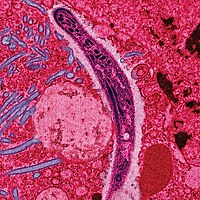
Photo from wikipedia
EUCAST has established clinical breakpoints for the six most common Candida species and Cryptococcus neoformans but not for less common yeasts because sufficient evidence is lacking. Consequently, the question “How… Click to show full abstract
EUCAST has established clinical breakpoints for the six most common Candida species and Cryptococcus neoformans but not for less common yeasts because sufficient evidence is lacking. Consequently, the question “How to interpret the MIC?” for other yeasts often arises. We propose a pragmatic classification for amphotericin B, anidulafungin, fluconazole, and voriconazole MICs against 30 different rare yeasts. This classification takes advantage of MIC data for more than 4000 isolates generated in the EUCAST Development Laboratory for Fungi validated by alignment to published EUCAST MIC data. The classification relies on the following two important assumptions: first, that when isolates are genetically related, pathogenicity and intrinsic susceptibility patterns may be similar; and second, that even if species are not phylogenetically related, the rare yeasts will likely respond to therapy, provided the MIC is comparable to that against wild-type isolates of more prevalent susceptible species because rare yeasts are most likely “rare” due to a lower pathogenicity. In addition, the treatment recommendations available in the current guidelines based on the in vivo efficacy data and clinical experience are taken into consideration. Needless to say, it is of utmost importance (a) to ascertain that the species identification is correct (using MALDI-TOF or sequencing), and (b) to re-test the isolate once or twice to confirm that the MIC is representative for the isolate (because of the inherent variability in MIC determinations). We hope this pragmatic guidance is helpful until evidence-based EUCAST breakpoints can be formally established.
Journal Title: Journal of Fungi
Year Published: 2022
Link to full text (if available)
Share on Social Media: Sign Up to like & get
recommendations!